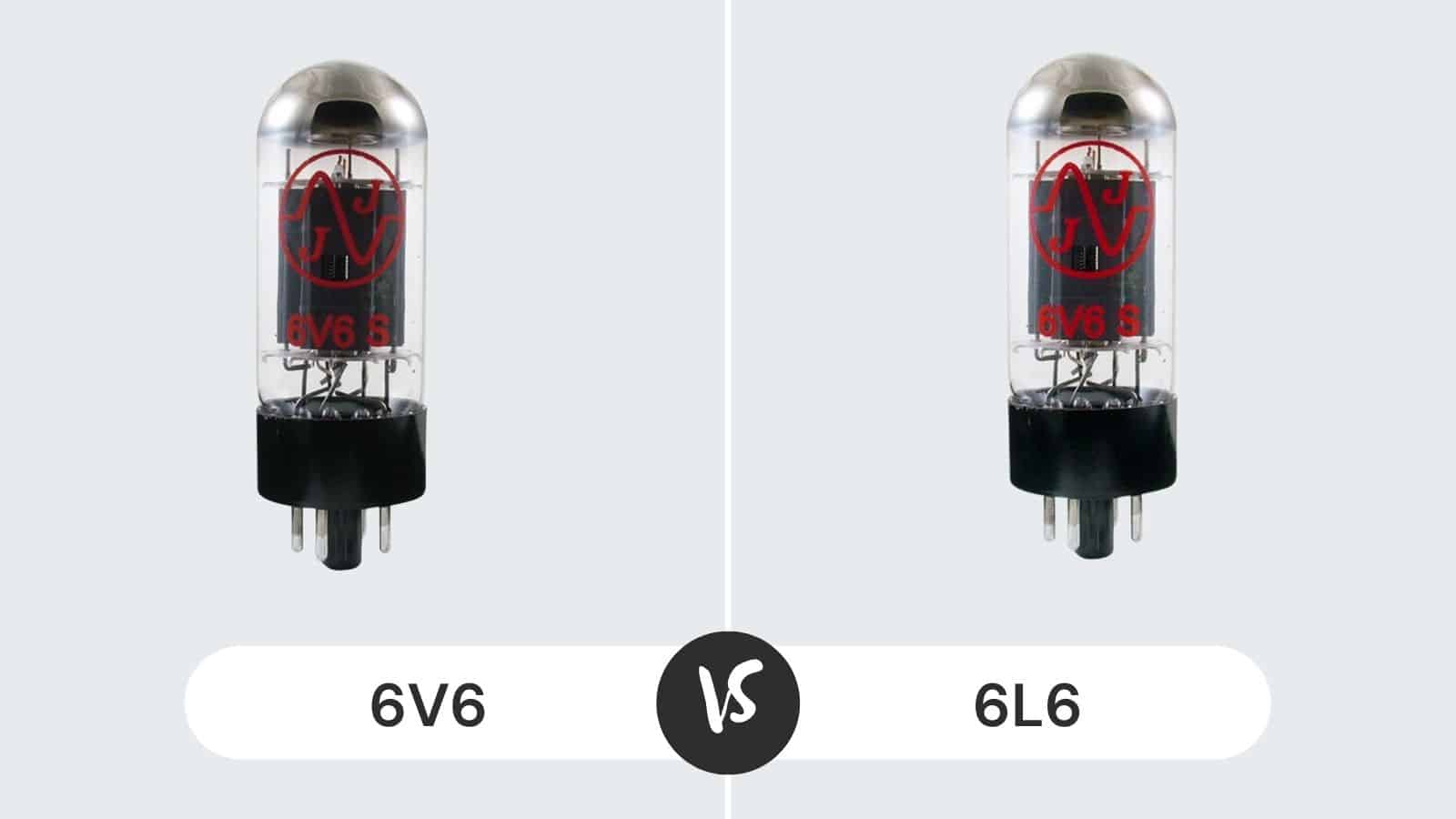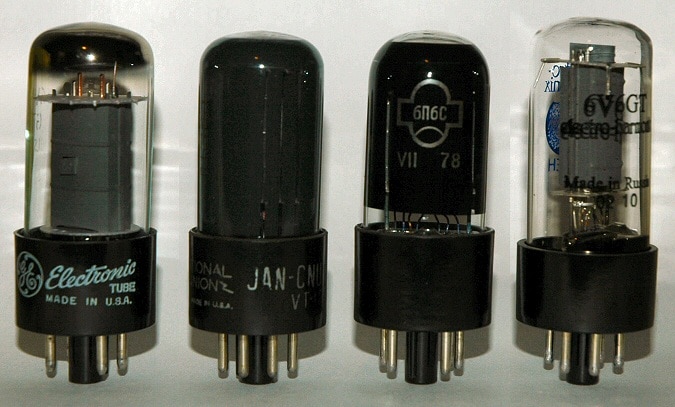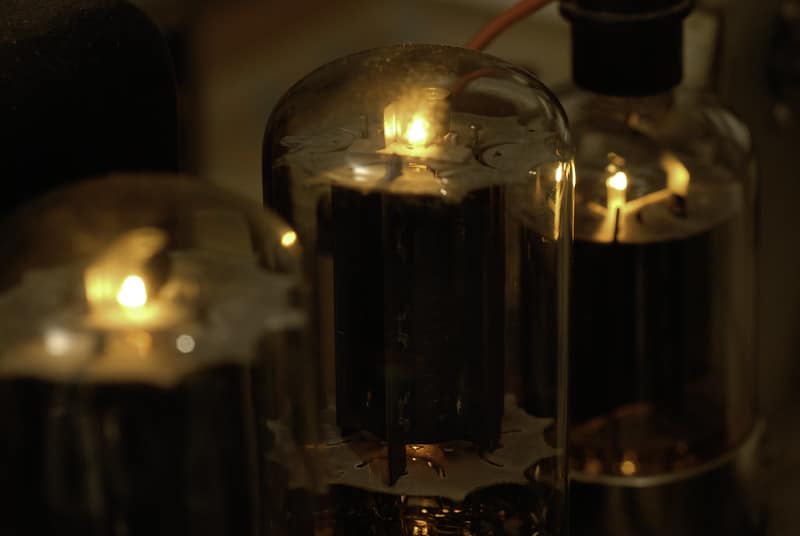
The output tubes of the guitar amp can significantly impact the character and voice of the music. These tubes can create different types of sounds, depending on the guitar’s playing style.
They can make the amp more responsive to the guitar, which helps add personality to the music. There are different types of tubes available, but 6V6 and 6L6 are the two most common tubes used in guitar amps.
Comparison Between 6V6 vs 6L6
| Features | 6V6 | 6L6 |
|---|---|---|
| Sound | Aggressive and snarling tones | Smooth and clean tones with mild harsh tones |
| Power | 14W with twin-tube and 5W with single tube | 55W |
| Headroom | Lower | Higher |
| Music Genre | Bass guitar, jazz, and blues music | Jazz and rock music |
| Sensitivity | High | Low |
6V6
6V6 is known as a beam tetrode tube that was first launched in 1936. It was first launched by Ken-Rad and Raytheon as they wanted to create a low-powered substitute for 6L6 to ensure less heater power consumption.
6V6 is the low-wattage amp tube that has a slacker low-end, but the highs are syrupy. These tubes are suitable for creating overdriven tones and tend to break up quickly if used at a higher volume.
One 6V6 tube can create around five watts of constant power. On the other hand, if you use a push-pull pair of these tubes, you can create around 14W of power.
These tubes can create highly prominent highs and focused lows, which results in solid and steady tones. This is the prime reason it’s used for creating all American tube sounds.
As compared to the EL-84 tubes, these tubes can produce 2x more power, given the vacuum design.
1. Sound Quality
The tubes have fewer low ends but have more mid. As a result, you will be able to achieve compressed sound, even if the volume goes high. This is why 6V6 tubes are suitable for bass guitar, jazz, and blues music.
The majority of guitarists like it for the girthed mids, along with dynamic and convenient compression. These tubes have a slightly gritty but smoother texture, which adds personality to the sound, particularly to the overdriven tones.
When used in pairs, 6V6 provides sufficient headroom along with a punchy and firm mid-range tone. The sound quality is extremely clear, and the overall tonality will be well-balanced.
6V6 is a small and low-output tube, which is why it cannot be used to produce a firm low-end.
Depending on which brand’s tubes you choose, they can also produce rock & roll and twang tones without compromising on the rawness of the music brew, resulting in refined output.
The tubes have an impressive definition for notes and produce a balanced range. It’s clear that the tube breaks up a little, but it still produces enough chime in the music.
When connected with the guitar, a 6V6 tube can deliver plumb and round music at the middle position, which adds warmth and richness to the sound brew.
The tube has a promising compression, which makes it a touch-sensitive and tactile tube to play with without any mushing.
The girthed midrange promises tighter lows while keeping the highs silky and clear. On the neck area, it will create thicker and darker music while avoiding muddiness. In simpler words, it can be used for retaining articulation and sweetness.
Overall, it’s a suitable choice for amps that you need to create classic volume and club-level music without adding any mudding to the amp. Overall, it’s an appealing, musical, and well-balanced tube.
2. Additional Information
The 6V6 tubes can handle 5W of maximum signal power or 14W in the case of twin-tube, which leads to a gritty yet warm sound. In case you want to break up the music at a low volume, it’s suggested to use 6V6 tubes.
These tubes have a less low end, which is why the sound is compressed whenever the volume is increased. For the same reason, these tubes tend to be more musical for blues music.
6L6
6L6 tubes were also first launched in 1936 but had different functionality and design as compared to 6V6 tubes. These tubes have 55 watts power connection, a maximum of 5.6k ohms of resistance, and 500v voltage.
These tubes are used as the power output tubes and are used for redefining the amplification of the guitars, and Fender was the first one to connect it with the amps in 1940.
The majority of these tubes are manufactured in Russia. Depending on the brand, these tubes will last over one year since it has a full-size base. It’s safe to say that 6L6 tubes are designed with rigid quality standards and need a higher voltage to work.
1. Sound Quality
6L6 tubes are available in different variations, including hard, medium, and soft, which impact the headroom. These tubes are widely used by musicians who like to use electronic guitars and electronic recording.
In addition, these tubes can be used for playing jazz and rock music. 6L6 tubes are widely used in amps for converting the input sound into a full and consistent sound during the amplification process.
It can create a warm and round tone, and it can be connected with modern amps as well as vintage amps to create a sweet sound. It delivers reliable balance in the music by offering significant headroom and volume at once.
The tubes can be used to achieve fresh sound on mid-range, lows, and highs. In the start, the tubes will create slightly harsh sound and over-bright, but it settles in after a few sessions and starts creating balanced sound.
In case you want more headroom, it is important to use the higher tubes. 6L6 tubes are designed with rigid quality standards, delivering promising harmony in the music.
On the other hand, some people have complained about distortion in the sound, but it’s very moderate and can be easily handled by switching to mid-range music.
The users will be able to create amazing sounds with balanced clarity. It also has a slight overdrive to balance the sound, clarity, and tones.
The best thing about the 6L6 tube is that it has a proper breakup level at the right time, making it a suitable choice for people who want higher fidelity and to optimize the audio quality. As a result, you will get sufficient sound and clarity in different music tones.
2. Additional Information
6L6 tubes can handle the maximum power output of 10.8W, which creates an all-tube smooth sound. These tubes tend to create more power, which means you can crank them louder and create clean music
It can create focused highs and low-ends to create a pleasant chime.
Are 6L6 & 6V6 Tubes Interchangeable?
Generally, it’s not possible to use 6L6 and 6V6 tubes interchangeably. This is because the amps are calibrated to be used with specific valves and aren’t suitable for multiple valve usage unless you modify the circuits.
Usually, people don’t know the amp design, which is why it’s best to stay away from modifying the tubes and circuit.
In particular, the circuit has to be rebiased, which can be a challenging task, so it’s best to get in touch with a technician. This is because a technician can handle the soldering to ensure the plate current, filament current, and output impedance are streamlined.
To begin with, the 6V6 tubes need a high load as compared to 6L6 tubes, and improper powering can cause permanent damage to the auxiliary components.
In simpler words, the 6LB tubes need more electrical power and space as compared to two 6V6 tubes, which can lead to burnout of the entire circuit.
So, it’s best that you don’t use them interchangeably because the manufacturers don’t state such options in the manual.
The Final Verdict
The 6L6 tubes are high-powered tubes and deliver warm and smooth tones. On the contrary, the 6V6 tubes have a lower power rating, resulting in snarling and aggressive tones. If you like to play blues and jazz music, you can use 6V6 tubes, but 6L6 tubes are suggested for jazz and rock music.


